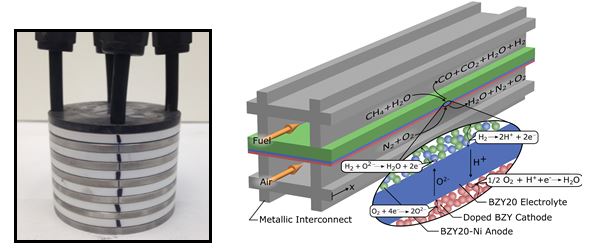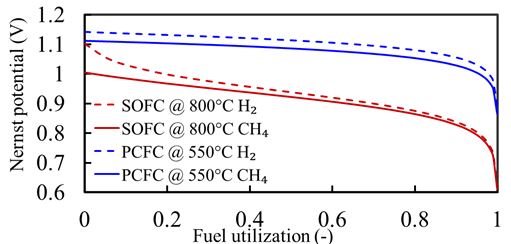Development of Intermediate-Temperature Fuel-Flexible Protonic-Ceramic Fuel Cells
This 5-year, $6.5M funded project is a part of the REBELS ARPA-E program and is focused on the development of an intermediate-temperature, protonic ceramic fuel cell (PCFC) technology. The realization of an intermediate-temperature, high-efficiency direct-reforming hydrocarbon-fueled fuel cell system is an unquestioned “holy grail” in the fuel cell community. Unfortunately, the commercialization of conventional, direct-hydrocarbon fuel cells based on solid-oxide fuel cell (SOFC) technology has historically been impeded by a number of challenges associated with high operating temperatures (800-1000°C), degradation and coking issues, and complex and expensive cell manufacturing. In collaboration with the CSM Profs. Robert J. Kee, Sandrine Ricote, Ryan O’Hayre and Neal Sullivan and Fuel Cell Energy, our team is developing a mixed proton (H+) and oxygen ion (O2-) conducting electrolyte that allows a fuel cell to operate at temperatures less than 500°C, which is a significant departure from today’s ceramic fuel cells. The benefits of the technology are fuel cell stack cost reductions of 25-40% compared with SOFCs1, fuel flexibility to operate directly on liquid hydrocarbons2-3 and electric efficiencies that could reach 70%-LHV without hybridization4.
The development of a new protonic ceramic fuel cell computational modeling framework is presented for a predictive cell-level, interface charge transfer PCFC model capturing the mixed conducting nature of the protonic ceramic materials5. The model employs a 1-D channel-level modeling strategy where fuel depletion and flow configuration effects are resolved and coupled to a semi-empirical electrochemical model. Modeling results calibrated against experimental data of a state-of-the-art PCFC composition are presented. The model is capable of simulating a fuel flexible PCFC where methane and steam without pre-reforming are fed directly into the anode gas channel.
FUNDING:DOE ARPA-E Program

6-cell PCFC stack, left, and PCFC channel and reactions

PCFC Operation Enables Higher Theoretical Fuel Utilizations than SOFC
Recent progress in the performance of intermediate temperature (500-600°C) protonic ceramic fuel cells (PCFCs ) has demonstrated both fuel flexibility and increasing power density that approach commercial application requirements. These developments may eventually position the technology as a viable alternative to solid oxide fuel cells (SOFCs) and molten carbonate fuel cells (MCFCs). The PCFCs investigated in this work are based on a BaZr0.8Y0.2O3-δ (BZY20) thin electrolyte supported by BZY20/Ni porous anodes, and a triple conducting cathode material comprised of BaCo0.4Fe0.4Zr0.1Y0.1O3-δ (BCFZY0.1). These cells are prepared using a low-cost solid-state reactive sintering (SSRS) process, and are capable of power densities of 0.156 W cm-2 at 500°C operating directly from methane fuel. We develop a manufacturing cost model to estimate the Nth generation production costs of PCFC stack technology using high volume manufacturing processes and compare them to the state-of-the-art in SOFC technology1. The low-cost cell manufacturing enabled by the SSRS technique compensates for the lower PCFC power density and the trade-off between operating temperature and efficiency enables the use of lower-cost stainless steel materials. PCFC stack production cost estimates are found to be as much as 27-37% lower at 550°C than SOFCs operating at 800°C.

Lower grade stainless steel enables cost reduction for current collector & interconnect

Cost analysis uncertainty still projects competitive PCFC vs. SOFC.
Publications
1 A. Dubois, S. Ricote, and R.J. Braun, Benchmarking the expected stack manufacturing cost of next generation, intermediate-temperature protonic ceramic fuel cells with solid oxide fuel cell technology, J. Power Sources 369 (2017) 65-77.
2 C. Duan, J. Tong, M. Shang, S. Nikodemski, M. Sanders, S. Ricote, A. Almansoori, R. O’Hayre, Readily processed protonic ceramic fuel cells with high performance at low temperatures, Science 349 (2015) 1321-1326.
3 C. Duan, S. Ricote, H. Zhu, N. Sullivan, C. Karakaya, R.J. Kee, R.J. Braun, R. O’Hayre, Highly durable, coking and sulfur tolerant, fuel-flexible protonic ceramic fuel cell, Nature, submitted (2017).
4 A. Dubois, R.J. Braun, Performance study of protonic ceramic fuel cell-based micro-combined heat and power system for residential and off-grid natural gas fueled applications, working paper for J.Power Sources (2018).
5 K.J. Albrecht, C. Duan, R. O’Hayre, R.J. Braun. “Modeling Intermediate Temperature Protonic Ceramic Fuel Cells.” ECS Transactions 68.1 (2015): 3165-3175.
